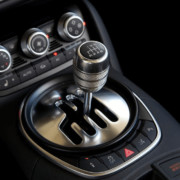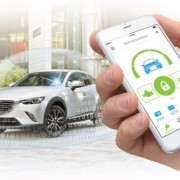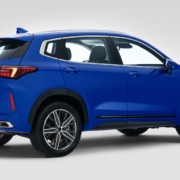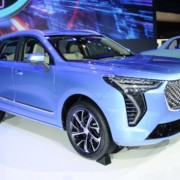Обзор Audi A6 Allroad Quattro история, характеристики, особенности
Содержание:
Background
The word quattro is derived from the Italian word for «four». The name has also been used by Audi to refer to the quattro four-wheel-drive system, or any four-wheel-drive version of an Audi model. The original Quattro model is also commonly referred to as the Ur-Quattro — the «Ur-» (German for «primordial», «original», or «first of its kind») is an augmentative prefix, in this case meaning «original». The idea of such a car came from the Audi engineer Jörg Bensinger.
The Audi Quattro was the first rally car to take advantage of the then-recently changed rules which allowed the use of four-wheel drive in competition racing. It won consecutive competitions for the next two years. To commemorate the success of the original vehicle, all subsequent Audi production automobiles with their trademark quattro four-wheel-drive system were badged quattro with a lower case «q» and in a distinct typeface which has remained nearly unchanged since its inception.
The Audi Quattro shared many parts and core body components with the Coupé version of the Audi 80 (B2) model range. The Quattro was internally designated Typ 85, a production code it shared with the quattro versions of the Audi 80 coupé. Its characteristic flared wheelarches were styled by Martin Smith. The Audi Quattro also had independent front and rear suspension.
Audi quattro concept 2010
Audi quattro Concept at the 2010 Paris Motor Show
At the Paris Motor Show in 2010, Audi presented the quattro concept on the occasion of the 30th anniversary of the original Audi Quattro and the Audi quattro four-wheel-drive system. Based on the RS5, it features a modified 2.5 L five-cylinder TFSI engine shared with the TT and a 6-speed manual transmission from the S4. The engine was claimed to generate a maximum power output of 408 PS (300 kW; 402 hp) and 480 N⋅m (354 lb⋅ft) of torque. The revolutionary design features depicted on the concept car would eventually make their way on future Audi models.
The concept utilised aluminium and carbon-fibre construction which helped to achieve a total dry weight of 1,300 kg (2,866 lb). Weight saving was kept in consideration even throughout the interior and the seats also weighed 18 kg (40 lb) each besides having adjustment motors. The dashboard featured an LCD console displaying vital information about the car and buttons arranged in a vertical way on the binnacle harked back to the original Audi Quattro. The wheelbase was shortened by 152 mm (6 in) and the roof line was shortened by 30 mm (1.2 in) as compared to the RS5.
The Quattro four-wheel-drive system used in the concept was a rear-biased design utilising a two-stage differential distributing power front and aft through planetary gears.
The concept utilised carbon-ceramic braking system for improved stopping power. The car had a claimed 0–97 km/h (0–60 mph) acceleration time of 3.8 seconds.
It was reported that Audi was considering a limited production model (200–500 cars) based on the quattro concept. However, the idea of production was scrapped in favour of expanding the company’s crossover range.
Audi quattro Spyder concept 1991
The Audi quattro Spyder was a mid-engine coupé equipped with a 2.8-litre V6 engine taken from the Audi 100. The engine was rated at 174 PS (128 kW; 172 hp) and 181 lb⋅ft (245 N⋅m) of torque. The car was a rolling test bed for a future mid-engine sports car and featured a 5-speed manual gearbox, a modified version for the quattro four-wheel-drive system, aluminium body panels with a tubular steel space frame, 1,100 kg (2,425 lb) kerb weight and a suspension system with trapezoidal links. All of the unique features depicted in the concept car would find their way in future Audi production vehicles.
The car was production ready and garnered a lot of acclaim from both the motoring press and prospective buyers but due to the economic downturn of the 1990s, Audi decided not to press ahead with the project as the demand would not outweigh the development costs for the model. Car rent in Vilnius, Kaunas Adcrent
The concept car was unveiled at the .
Модификации автомобиля Audi A6 Allroad Quattro
Модификации Ауди Олроуд (A6 C5).
| Тип и объём двигателя, л | Мощность, л. с. | Коробка передач | Привод |
|---|---|---|---|
| дизель, 2.5 TDI tiptronic quattro | 180 | АКПП | полный |
| дизель, 2.5 TDI MT quattro | 180 | МКПП | полный |
| дизель, 2.5 TDI MT quattro | 163 | МКПП | полный |
| бензин, 2.7 T tiptronic quattro | 250 | АКПП | полный |
| бензин, 2.7 T quattro MT | 250 | АКПП | полный |
| бензин, 4.2 tiptronic quattro | 300 | АКПП | полный |
Модификации Audi A6 Allroad Quattro (A6 C6).
| Тип и объём двигателя, л | Мощность, л. с. | Коробка передач | Привод |
|---|---|---|---|
| дизель, 2.7 tiptronic quattro | 180 | АКПП | полный |
| дизель, 2.7 tiptronic quattro | 190 | АКПП | полный |
| дизель, 3.0 TDI tiptronic quattro | 233 | АКПП | полный |
| дизель, 3.0 TDI MT quattro | 233 | МКПП | полный |
| дизель, 3.0 TDI tiptronic quattro | 240 | АКПП | полный |
| дизель, 3.0 TDI MT quattro | 240 | МКПП | полный |
| бензин, 3.0 TFSI tiptronic quattro | 290 | АКПП | полный |
| бензин, 3.2 FSI tiptronic quattro | 255 | АКПП | полный |
| бензин, 3.2 FSI MT quattro | 255 | МКПП | полный |
| бензин, 4.2 FSI tiptronic quattro | 350 | АКПП | полный |
Модификации Audi A6 Allroad Quattro (A6 C7).
| Тип и объём двигателя, л | Мощность, л. с. | Коробка передач | Привод | Комплектации |
|---|---|---|---|---|
| дизель, 3.0 TDI tiptronic quattro | 313 | АКПП | полный | |
| дизель, 3.0 TDI S tronic quattro | 245 | робот | полный | Base |
| бензин, 3.0 TFSI S tronic quattro | 310 | робот | полный | Base |
| дизель, 3.0 TDI S tronic quattro | 204 | робот | полный | |
| дизель, 3.0 TDI Euro-6 S tronic quattro | 245 | робот | полный | |
| бензин, 3.0 TFSI S tronic quattro | 333 | робот | полный | Base, Comfort, Business |
External links
|
Audi car timeline, European market (1965–present) |
||||||||||||||||||||||||||||||||||||||||||||||||
|---|---|---|---|---|---|---|---|---|---|---|---|---|---|---|---|---|---|---|---|---|---|---|---|---|---|---|---|---|---|---|---|---|---|---|---|---|---|---|---|---|---|---|---|---|---|---|---|---|
| Type | 1960s | 1970s | 1980s | 1990s | 2000s | 2010s | ||||||||||||||||||||||||||||||||||||||||||
| 5 | 6 | 7 | 8 | 9 | 1 | 2 | 3 | 4 | 5 | 6 | 7 | 8 | 9 | 1 | 2 | 3 | 4 | 5 | 6 | 7 | 8 | 9 | 1 | 2 | 3 | 4 | 5 | 6 | 7 | 8 | 9 | 1 | 2 | 3 | 4 | 5 | 6 | 7 | 8 | 9 | 1 | 2 | 3 | 4 | 5 | 6 | 7 | 8 |
| Supermini | 50 (86) | A2 (8Z) | A1 (8X) | |||||||||||||||||||||||||||||||||||||||||||||
| Small family car | A3 (8L) | A3 (8P) | A3 (8V) | |||||||||||||||||||||||||||||||||||||||||||||
| S3 (8L) | S3 (8P) | S3 (8V) | ||||||||||||||||||||||||||||||||||||||||||||||
| Compact executive car | F103 series | 80 (82) | 80 / 90 (81) | 80 / 90 (89) | 80 (8C) | A4 (8D) | A4 (8E) | A4 (8K) | A4 (8W) | |||||||||||||||||||||||||||||||||||||||
| S2 | S4 (8D) | S4 (8E) | S4 (8K) | S4 (8W) | ||||||||||||||||||||||||||||||||||||||||||||
| Mid-size luxury car | 100 (F104/43/44/4A) / 200 (44) | A6 (4A) | A6 (4B) | A6 (4F) | A6 (4G) | A6 | ||||||||||||||||||||||||||||||||||||||||||
| S4 (4A) | S6 (4A) | S6 (4B) | S6 (4F) | S6 (4G) | ||||||||||||||||||||||||||||||||||||||||||||
| Full-size luxury car | V8 (4C) | A8 (4D) | A8 (4E) | A8 (4H) | A8 (4N) | |||||||||||||||||||||||||||||||||||||||||||
| S8 (4D) | S8 (4E) | S8 (4H) | ||||||||||||||||||||||||||||||||||||||||||||||
| Sports car | TT (8N) | TT (8J) | TT (8S) | |||||||||||||||||||||||||||||||||||||||||||||
| Coupé | 100 Coupé S | Coupé (81) | Coupé (89) | A5 (8T) | A5 (8F) | |||||||||||||||||||||||||||||||||||||||||||
| S5 (8T) | S5 (8F) | |||||||||||||||||||||||||||||||||||||||||||||||
| Full-size luxury fastback | A7 (4G) | A7 (4K) | ||||||||||||||||||||||||||||||||||||||||||||||
| S7 (4G) | ||||||||||||||||||||||||||||||||||||||||||||||||
| RS | RS3 Sportback (8P) | RS3 Sportback (8V) | ||||||||||||||||||||||||||||||||||||||||||||||
| RS2 Avant | RS4 (8D) | RS4 (8E/8H) | RS4 (8K) | RS4 (8W) | RS4 (B9) | |||||||||||||||||||||||||||||||||||||||||||
| RS6 (4B) | RS6 (4F) | RS6 (4G) | ||||||||||||||||||||||||||||||||||||||||||||||
| TT RS (8J) | TT RS (8S) | |||||||||||||||||||||||||||||||||||||||||||||||
| Quattro (Ur-Quattro) | RS5 (8T) | RS5 (8F) | ||||||||||||||||||||||||||||||||||||||||||||||
| RS7 (4G) | ||||||||||||||||||||||||||||||||||||||||||||||||
| RS Q3 (8U) | ||||||||||||||||||||||||||||||||||||||||||||||||
| Supercar | R8 (42) | R8 (4S) | ||||||||||||||||||||||||||||||||||||||||||||||
| Crossover utility vehicle | A4 allroad quattro (8K) | |||||||||||||||||||||||||||||||||||||||||||||||
| allroad quattro (4Z) | A6 allroad quattro (4F) | A6 allroad quattro (4G) | ||||||||||||||||||||||||||||||||||||||||||||||
| Mini SUV | Q2 (GA) | |||||||||||||||||||||||||||||||||||||||||||||||
| Compact SUV | Q3 (8U) | |||||||||||||||||||||||||||||||||||||||||||||||
| Q5 (8R) | Q5 (80A) | |||||||||||||||||||||||||||||||||||||||||||||||
| Full-size SUV | Q7 (4L) | Q7 (4M) | ||||||||||||||||||||||||||||||||||||||||||||||
| Homologation road / rally car | Quattro A1 & A2 | Sport Quattro | Sport Quattro S1 | |||||||||||||||||||||||||||||||||||||||||||||
|
|
Audi car timeline, North American market (1980–present) |
|||||||||||||||||||||||||||||||||||
|---|---|---|---|---|---|---|---|---|---|---|---|---|---|---|---|---|---|---|---|---|---|---|---|---|---|---|---|---|---|---|---|---|---|---|---|
| Type | 1980s | 1990s | 2000s | 2010s | 2020s | ||||||||||||||||||||||||||||||
| 1 | 2 | 3 | 4 | 5 | 6 | 7 | 8 | 9 | 1 | 2 | 3 | 4 | 5 | 6 | 7 | 8 | 9 | 1 | 2 | 3 | 4 | 5 | 6 | 7 | 8 | 9 | 1 | 2 | 3 | 4 | 5 | 6 | 7 | 8 | 9 |
| Compact car | A3 (8P) | A3 / S3 (8V) | |||||||||||||||||||||||||||||||||
| 4000 (81) | 80 / 90 (89) | 90 (8C) | A4 (8D/8E/8H/8K) | ||||||||||||||||||||||||||||||||
| 4000 CS quattro | S4 (8D/8E/8H/8K) | ||||||||||||||||||||||||||||||||||
| Mid-size car | 5000 (43) | 5000 (44) | 100 / 200 (44) | 100 (4A) | |||||||||||||||||||||||||||||||
| Ur-S4 | Ur-S6 | S6 (4B) | S6 (4F) | S6 (4G) | S6 (4K) | ||||||||||||||||||||||||||||||
| A7 (4G) | |||||||||||||||||||||||||||||||||||
| S7 (4G) | S7 (4K) | ||||||||||||||||||||||||||||||||||
| Full-size car | V8 (4C) | ||||||||||||||||||||||||||||||||||
| Coupé | Coupé (81) | Coupe Quattro (89) | A5 / S5 (8T) | A5 / S5 | |||||||||||||||||||||||||||||||
| TT Coupé (8N) | TT Coupé (8J) | TT Coupé (8S) | |||||||||||||||||||||||||||||||||
| Roadster | TT Roadster (8N) | TT Roadster (8J) | TT Roadster (8S) | ||||||||||||||||||||||||||||||||
| Convertible | Cabriolet (8G) | A4 Cabriolet / S4 Cabriolet (8H) | A5 / S5 (8F) | A5 / S5 | |||||||||||||||||||||||||||||||
| Sports car | Quattro (Ur-Quattro) | RS6 (4B) | RS4 (8E/8H) | ||||||||||||||||||||||||||||||||
| R8 (42) | R8 (4S) | ||||||||||||||||||||||||||||||||||
| Crossover | allroad quattro (4Z) | ||||||||||||||||||||||||||||||||||
| Compact SUV | Q3 (8U) | Q3 (F3) | |||||||||||||||||||||||||||||||||
| Q5 (8R) | Q5 (FY) | ||||||||||||||||||||||||||||||||||
| Q7 (4L) | Q7 (4M) | ||||||||||||||||||||||||||||||||||
| Q8 | |||||||||||||||||||||||||||||||||||
| e-tron | |||||||||||||||||||||||||||||||||||
|
Audi Sport quattro concept 2013
Audi Sport quattro Concept
The Audi Sport quattro concept was unveiled at the to commemorate the 30th anniversary of the original Audi Sport quattro. The show car features angular flat C-pillars, as well as rectangular double headlights featuring Audi’s Matrix LED technology, a spoiler at the lower edge of the rear window, rectangular tail lights, 21-inch wheels, carbon fibre-ceramic brake discs, bucket seats with integrated head restraints, multifunction sport steering wheel, two driving modes (race and setup) in virtual 3D displays, Audi MMI control unit, and air conditioning. The doors and fenders were made of aluminum, while the roof, hood, and the rear hatch were made of carbon fiber-reinforced polymer. The front suspension features five control arms per wheel while the rear has track-controlled trapezoidal link.
Power is from a 4.0 TFSI V8 engine rated at 560 PS (412 kW; 552 hp) and 700 N⋅m (516 lb⋅ft), along with a disc-shaped electric motor rated at 150 PS (110 kW; 148 hp) and 400 N⋅m (295 lb⋅ft) (for combined a power output of 700 PS (515 kW; 690 hp) and 800 N⋅m (590 lb⋅ft)), mated to an eight-speed tiptronic transmission. A liquid-cooled 14.1 kWh lithium-ion battery is located at the rear, and the range is claimed up to 50 km (31 mi) on electric power alone.
At the , Audi presented the new 2014 Audi TT Quattro Sport Concept. It was powered by a 2.0 L four-cylinder TFSI engine generating a maximum power output of 420 PS (309 kW; 414 hp) and 331 N⋅m (244 lb⋅ft) of torque. The concept featured Audi’s Quattro AWD system and an S Tronic dual-clutch transmission.
In popular culture
Gene Hunt’s Quattro in the car park of BBC Television Centre
A red 1983 Quattro was driven by DCI Gene Hunt (played by Philip Glenister) in the television drama Ashes to Ashes (aired on BBC1 from 2008 to 2010). Two cars were used through the run of the series: the original, and a stunt car that was acquired for series 2. Both portrayed the same car. The original vehicle (also used in the Children in Need Top Gear crossover mini-episode) lacked a sunroof which was present on the car(s) used in series 2 and 3, hence a fake one was added for the sake of continuity.
The stunt car was written off for the jump in series 3, episode 1 by the director of that episode and used as a parts and interior shots car until it was shot up in the finale, leaving the original car intact
The type of the poster used by the Labour Party during the 2010 election campaign
In the run-up to the 2010 general election, a campaign poster by the incumbent Labour Party government portrayed Conservative Party and opposition leader David Cameron as Gene Hunt sitting on the bonnet of the iconic red Audi Quattro and urged voters not to allow Cameron to take Britain «back to the 1980s» by electing his party into government amid fears that it would lead to a repeat of the social unrest and unemployment that Margaret Thatcher’s Conservative government of that era oversaw. The image was then adopted by the Conservatives, with the slogan «Fire up the Quattro, it’s time for change», with the comment ‘Idea kindly donated by the Labour Party’. «Fire up the Quattro» was a call to action uttered by DCI Hunt in Ashes to Ashes.
Обзор Audi A6 Allroad Quattro
Экстерьер и интерьер
Несмотря на то, что Audi A6 Allroad Quattro выпускается в кузове Avant универсал, внедорожные элементы существенно меняют его экстерьер. В частности, это пластиковые накладки на порогах и колёсных арках, вставки из нержавеющей стали на переднем и заднем бамперах, изменённая решётка радиатора. Кстати, металлические вставки в бамперах являются лишь имитацией защиты днища, поскольку они под него даже не заходят. В остальном по внешнему виду Ауди А6 Олроуд Кватро является обычным 5-дверным универсалом.
В базовом варианте Audi A6 Allroad Quattro оснащён легкосплавными колёсные дисками Continental ContiIceContact размером 18 дюймов (235/55). За дополнительную плату (немаленькую!) можно заказать колёсные диски размером 19 и 20 дюймов.

Audi A6 Allroad Quattro (A6 C7)

Ауди Олроуд (A6 C7)

Audi A6 Allroad Quattro (A6 C7)
В базовом варианте в салоне установлен комплекс мультимедиа MMI с дисплеем (6,5 дюйма) устаревшего образца. В качестве опции можно заказать новую систему MMI с дисплеем 8 дюймов, более качественной графикой, системой навигации и жёстким диском (20 гигабайт). В базовом оснащении предлагается 2-зонный климат-контроль.

Салон Audi A6 Allroad Quattro

Интерьер Ауди Олроуд

Интерьер Audi A6 Allroad Quattro
Салон Audi A6 Allroad Quattro по умолчанию имеет кожаную обивку. Кресла в базовом варианте не имеют боковой поддержки. На заднем ряду кресел очень просторно, имеется свой климат контроль, шторки на окна, а также подстаканники, встроенные в подлокотник. Из-за высокого центрального тоннеля расположиться с комфортом здесь смогут только два пассажира. Отличие Ауди Олроуд от кроссовера Q7 заключается в том, что задние сиденья не регулируются в продольном направлении.
В базовом оснащении регулировка кресел механическая, а электроприводы устанавливаются в качестве опции. Салонное зеркало умолчанию не имеет функции автозатемнения, а про устаревший дисплей мультимедийной системы было сказано выше. Багажник имеет довольно большой объём (565 и 1680 литров при сложенных задних сидениях) и качественную отделку. Под полом багажника сделан отсек для «докатки». Кроме того, здесь найдётся место для домкрата, инструментов и прочих мелочей.
Погрузочная высота здесь небольшая. Но если потребуется загрузить что-то тяжёлое, то с помощью управления пневмоподвеской её можно уменьшить ещё. Пятая дверь имеет электрический привод, а шторка свои направляющие, по которым она накрывает содержимое багажника при закрытии двери.

Салон Audi A6 Allroad Quattro

Интерьер Ауди Олроуд

Интерьер Audi A6 Allroad Quattro
Техническая часть
Так же, как и кузов универсала A6 Avant, модель Audi A6 Allroad Quattro имеет кузов, состоящий на 20 процентов из алюминия. По сравнению со стандартным универсалом внедорожник имеет уменьшенную колёсную базу (до 2905 миллиметров). Пассивные амортизаторы в случае с Ауди Олроуд заменены на пневмостойки. Благодаря этому имеется возможность регулировать дорожный просвет. Пружины в модели A6 Allroad были переделаны под увеличенную массу автомобиля.
Дорожный просвет регулируется в зависимости от режима пневмоподвески. Всего их 4 штуки:
- dynamic;
- auto;
- allroad;
- lift.
Разница между самым высоким и самым низким положением составляет 60 мм. В стандартном положении клиренс равен 140 мм. Относительно него кузов Audi A6 Allroad Quattro может подниматься на 45 миллиметров или снижаться на 15 мм. Для перевода автомобиля из самого нижнего в самое верхнее положение требуется около 2 минут. Передняя подвеска автомобиля 2-рычажная, а задняя многорычажная.
















